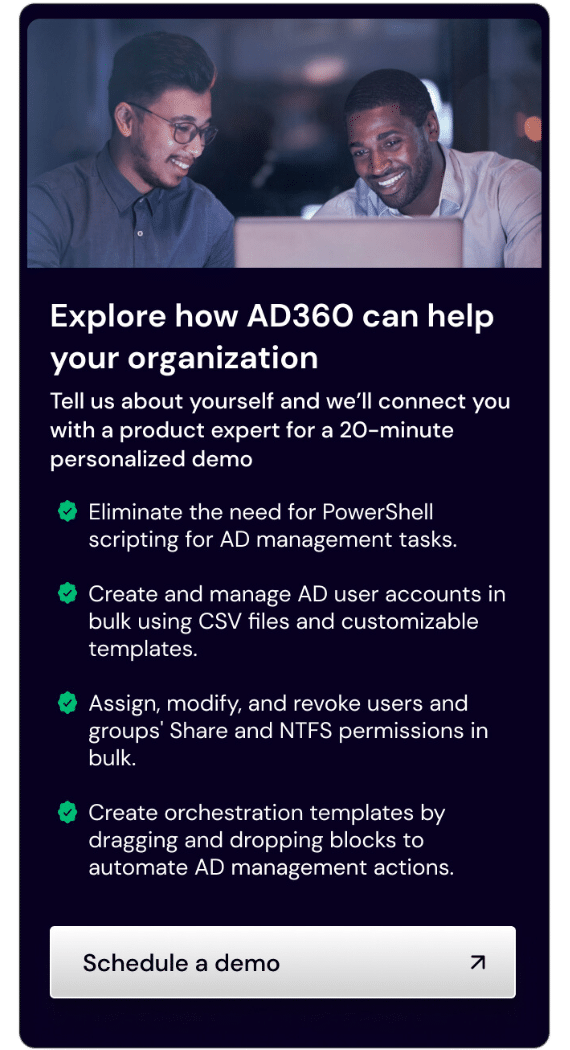
A timeless reference on why permission sprawl happens due to excess permissions, how it breaks defenses, and the exact steps to unwind it—especially in legacy Active Directory and hybrid estates – Security Architecture/Active DirectoryLeast Privilege
The surface view vs. the real problem
At the surface level, “excess permissions” are defined as access rights beyond what a user requires to do their job. Security frameworks summarize this as the principle of least privilege: give people the minimum rights necessary, nothing more.
This framing is correct but incomplete. In practice, excess permissions rarely appear in neat, intentional packages. Instead, they emerge gradually through:
- Role changes – A user moves from Finance to HR but retains access to both.
- Temporary fixes – Admins grant broad rights “just for now” during a project, then forget to revoke them.
- Application upgrades – New versions inherit all old ACLs, even if they’re no longer relevant.
- Orphaned groups – Nested groups retain outdated memberships that nobody remembers.
The result is a labyrinth of access paths, often invisible until something goes wrong.
Think of permissions as doors in a vast building. Over time, doors are added, locks are changed, and keys are duplicated. If no one maps the entire system, you eventually have people holding master keys they should never have, with nobody quite sure which doors still exist.
Why permission sprawl happens
To understand excess permissions, we must reduce the problem to its core truths. At its foundation, any access control system rests on three principles:
- Identity persistence – Once created, identities (user accounts, groups, service principals) are rarely deleted. Administrators fear breaking something.
- Access asymmetry – It is always easier to grant permissions than to remove them. Adding access solves problems instantly; revoking access risks outages.
- Audit friction – Visibility into effective permissions is inherently hard. Between inheritance, delegation, and nested groups, no human can track it all intuitively.
From these truths, sprawl is inevitable. Unless an organization has active, automated hygiene processes, every year adds layers of unnecessary access. Legacy setups amplify this because they predate current security best practices—what was once “good enough” becomes dangerously excessive today.
Technical Playbook: Detecting and remediating excess permissions in Legacy AD
When dealing with legacy Active Directory setups, excess permissions can be systematically uncovered and remediated through a structured technical process. The following sequence provides a practical framework:
1. Enumerate Privileged Groups and Accounts
- Use
net groups "Domain Admins" /domainor PowerShell:
Get-ADGroupMember "Domain Admins" -Recursive- Expand beyond Domain Admins: check Enterprise Admins, Schema Admins, Account Operators, and custom groups with elevated rights.
- Document all nested memberships—permissions often hide in layers of groups.
2. Identify Orphaned and Dormant Accounts
- List accounts with no recent logons (e.g., 90+ days):
Search-ADAccount -AccountInactive -TimeSpan 90.00:00:00 -UsersOnly- Flag service accounts with non-expiring passwords.
- Disable, quarantine, or investigate accounts no longer in use.
3. Map Effective Permissions on Critical Objects
- Use
dsaclsto dump ACLs on sensitive containers (Domain Root, OU=Admins, OU=Servers). Example:
dsacls "DC=contoso,DC=com"- Look for non-default ACEs granting
Full Control,GenericAll, orWriteDACL. - Pay special attention to permissions on AdminSDHolder—these propagate to protected groups.
4. Audit Group Nesting and Delegation
- Flatten nested groups with PowerShell:
Get-ADGroupMember -Identity "Helpdesk" -Recursive- Identify groups that include broad user categories (e.g., Domain Users, Everyone) in elevated roles.
- Review delegated permissions on OUs via ADUC’s Advanced Security view or PowerShell’s
Get-ACL.
5. Cross-Reference with File Shares and GPOs
- Run access enumerations on file servers:
Get-SmbShareAccess -Name *- Spot overly permissive entries like
Everyone:ForAuthenticated Users:Modify. - Check Group Policy for “Restricted Groups” or “Preferences” that assign excessive rights.
6. Apply Just-In-Time (JIT) and Just-Enough-Administration (JEA)
- For admin accounts, replace standing access with JIT via Privileged Access Management (PAM).
- Use JEA to define PowerShell endpoints limiting what commands privileged users can run.
7. Automate Recertification
- Export entitlements into CSV or IAM tools for manager reviews.
- Implement recurring jobs to detect newly over-privileged accounts.
8. Remediation Strategy
- Prioritize high-value targets: Domain Admins, GPOs, DC ACLs, Tier-0 servers.
- Stage revocations—remove access incrementally and monitor impact.
- Document every change to avoid untraceable “fix drift.”
Expert mental models for understanding Excess Permissions
Experts don’t just see permissions as a list of rights. They use mental models that cut through the noise and reveal the true shape of the system. Here are five that consistently unlock deeper understanding:
- The Attack Surface Lens
Excess permissions are not “inconvenient clutter”—they are live entry points. Every unneeded right is a possible pivot for lateral movement. Thinking in terms of attack surface reframes the issue from hygiene to active defense. - The Entitlement Debt Model
Just as organizations accumulate technical debt, they accumulate entitlement debt. Every quick fix or unrevoked privilege adds to future risk. Entitlement debt compounds silently until the “interest” is paid in breaches or compliance failures. - The Privilege Inversion Principle
In many legacy setups, the people with the least business need (contractors, abandoned service accounts) often end up with the most powerful rights, simply because no one cleaned up. Privilege inversion is one of the starkest signs of neglect. - The Trust Horizon
Permissions should decay over time unless re-validated. The longer access persists without review, the further it moves beyond the “trust horizon.” Beyond that horizon, you should assume the permission is unjustified until proven otherwise. - The Mapping Fallacy
Many teams think a spreadsheet or static report can capture permissions. But access is dynamic. Without continuous monitoring, any “map” is outdated the moment it’s made. Experts treat access visibility as a living process, not a one-time artifact.
Misunderstandings, Risks, and Correctives
Most organizations underestimate excess permissions because of three common misconceptions:
- “If it hasn’t been exploited, it must be safe.”
False. Excess permissions are latent risk. They don’t cause problems until an insider abuses them or an attacker discovers them. - “We can rely on trust.”
Dangerous. Insider threat is consistently among the top breach vectors. Even trusted users make mistakes, and accounts can be compromised. - “We’ll fix it during the next upgrade.”
Rarely true. Upgrades tend to carry old permissions forward, not reduce them. Without deliberate cleanup, migrations preserve and amplify sprawl.
Expert Essentials Checklist
- Map effective permissions, not just group memberships.
- Apply time-bound access wherever possible (Just-in-Time, expiring links).
- Treat dormant accounts and groups as toxic until validated.
- Automate entitlement reviews—manual audits always miss details.
- Embed least privilege as a living process, not a one-off project.
Applications and Forward Look
Excess permissions influence far more than compliance checklists. They ripple across strategic IT decisions:
- Incident Response
In a breach, excess permissions expand the blast radius. Attackers escalate faster, and incident responders spend precious time untangling inherited rights. - Cloud Migrations
When organizations lift-and-shift to Azure AD or hybrid cloud, they carry legacy sprawl with them. Excess permissions that seemed tolerable on-prem become catastrophic in the cloud’s exposed perimeter. - Zero Trust Architectures
Zero Trust is not achievable without controlling entitlements. Every excessive permission undermines the “never trust, always verify” model.
Looking ahead, two trends stand out:
- Automated Entitlement Management
AI-driven systems will increasingly baseline “normal” access and flag anomalies. Manual cleanup won’t scale for large enterprises. - Regulatory Pressure
Frameworks like NIST 800-53 and ISO 27001 are already tightening requirements on least privilege. Expect regulators to demand provable entitlement management in the next five years.
Lessons from Legacy: A Case Study Approach
Consider a real-world style scenario:
A mid-sized enterprise has run Active Directory since 2005. Over the years, dozens of business units have spun up their own groups. Some projects ended, but the groups remain. Contractors had accounts that were never disabled. Service accounts for old applications still exist, with Domain Admin rights.
When the organization faced a ransomware incident, the attackers compromised a single helpdesk account. Because that account was nested into an old “IT Support Global” group, the attacker gained rights across multiple regions. Recovery took weeks, and forensic investigators traced the root cause to forgotten excess permissions dating back to 2011.
This is not a rare story—it is the rule. Every mature environment has similar skeletons. The lesson is clear: legacy setups are not neutral; they are active vulnerabilities if unmanaged.
Key Takeaways & Wrap-Up
Excess permissions are more than untidy administration. They are structural weaknesses baked into the history of your environment. Left unchecked, they become silent enablers of breaches, outages, and compliance failures.
The core truths are unavoidable: identities persist, access is easier to grant than revoke, and visibility is hard. But experts know how to counter these tendencies—with mental models, automated reviews, and a relentless focus on least privilege as a process, not a project.
Every organization with a legacy directory or hybrid setup should treat entitlement cleanup as strategic risk reduction. The cost of doing nothing is not hypothetical—it is measured in ransomware payouts, regulatory fines, and reputational damage.
Start Reducing Entitlement Debt Today
Kick off a focused 30-day cleanup using the Technical Playbook above. Pair it with quarterly recertifications to keep drift in check.
Here’s some more resources:


